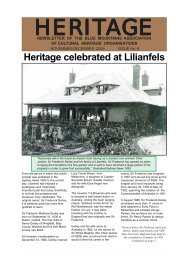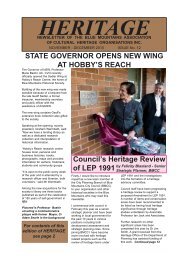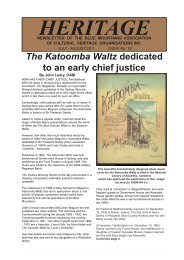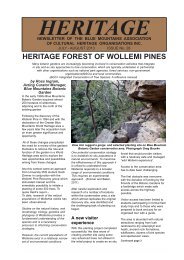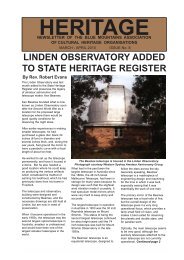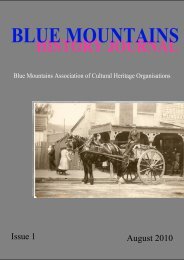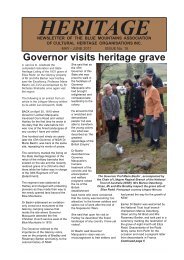Blue Mountains History Journal Issue 2
Blue Mountains History Journal Issue 2
Blue Mountains History Journal Issue 2
You also want an ePaper? Increase the reach of your titles
YUMPU automatically turns print PDFs into web optimized ePapers that Google loves.
<strong>Blue</strong> <strong>Mountains</strong> <strong>History</strong> <strong>Journal</strong> 2; 2011<br />
One description of the cave is:<br />
“...near the top of the valley is a cave church – a tiny mountain sanctuary, adapted for Divine worship<br />
by the walling in of the front of a small cave.” (Oreinos 1898, p.28, col.1).<br />
Previously in November 1894 it had been reported:<br />
“The cave at the rear of Mr. Hargrave’s residence, where Church of England services are held every<br />
Sunday afternoon by the Rev. H.M. Trickett (of Blackheath), has recently been improved, thus<br />
making it much more comfortable.” (Anonymous 1894b).<br />
Then in 1895 a fireplace was added and later<br />
“... among the congregation were Mr. John See, and three other members of Parliament. We believe<br />
sufficient money had been collected by residents to purchase an organ so that the services may be<br />
somewhat brighter by the infusion of music.” (Anonymous 1895).<br />
A year later it was stated:<br />
“This is a charming spot overlooking the beautiful Kanimbla Valley (actually the Megalong Valley<br />
- Editor), and forms a unique cave house, a front wall being built up, and doors and windows put in<br />
and these with other improvements such as a fireplace making it as comfortable a place as could be<br />
desired. Nearly all the natural beauty is retained, and the cave forms a splendid arbor for Mr.<br />
Hargraves to entertain any friends. Services are conducted every Sunday afternoon in the cave by<br />
Rev. P.W. Dowe, of St. Aidan’s Blackheath and on Easter Sunday the cave was beautifully decorated.<br />
This was the occasion of a visit from our representative by special invitation, and he was delighted<br />
with what he saw.” (Anonymous 1896).<br />
As many as 70 have been known to attend services (J.A.X.M. 1895) which, for the longest span of<br />
time, were conducted by the Rev Philip William Dowe, Curate-in-Charge of St. Aidan’s Church of<br />
England in the Parish of Blackheath from 1895 until 1901 (Finney 2005, p.592). Usually they were<br />
held at 4.00 p.m. except when it was wet (as on 30 May 1897 - Hodgkinson post 1984), due to the fact<br />
that the minister had to travel by horse and buggy. The last set of ‘Church Notices’ to mention the cave<br />
church was in The Mountaineer 18 June 1897 (Anonymous 1897) for none of the surviving later issues<br />
of that newspaper had such a section. Special functions have been recorded too:<br />
“More than one pretty marriage was also solemnised in that cave.” (Has-been 1915).<br />
The earliest known image of the Cave Church dates from 1898 and it is also the only one known to<br />
have been published (Figure 4); it shows the<br />
exterior complete with the chimney that was<br />
installed about three years earlier but which no<br />
longer exists (Figure 5).<br />
Figure 4. “6. Church Caves (sic), with<br />
Seating Accommodation for 80.” -<br />
Anonymous (1898).<br />
17 Back to Contents




